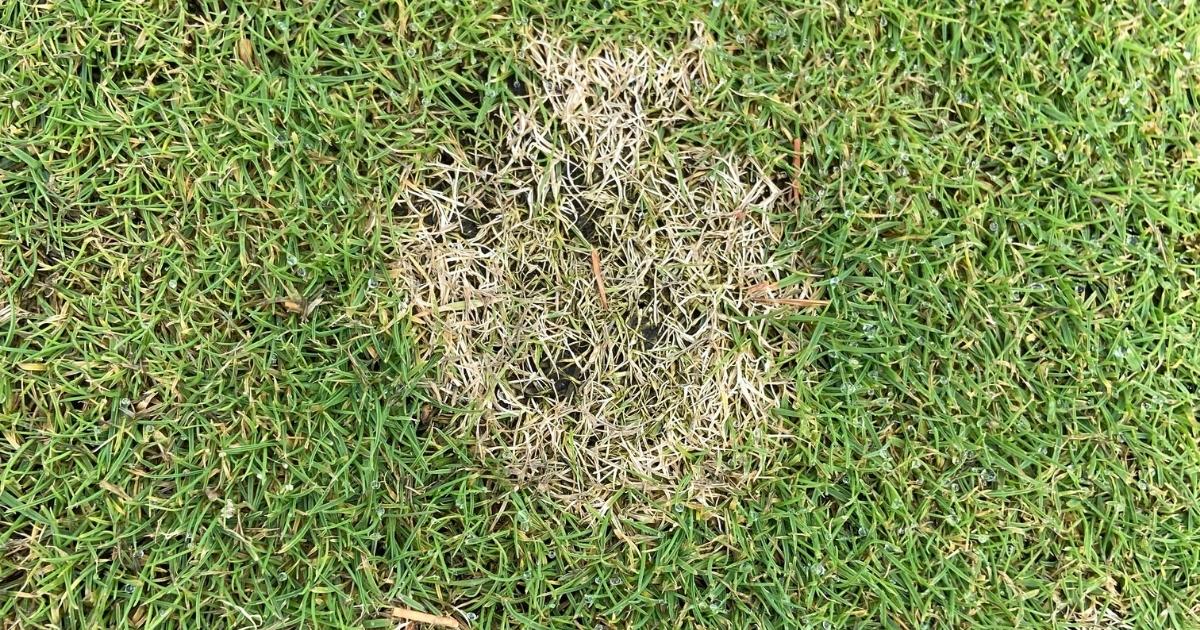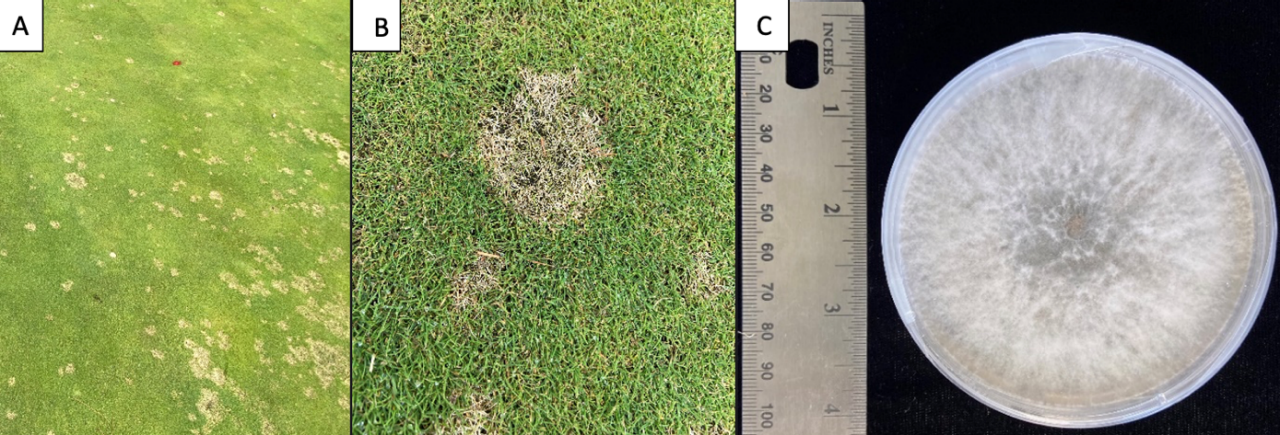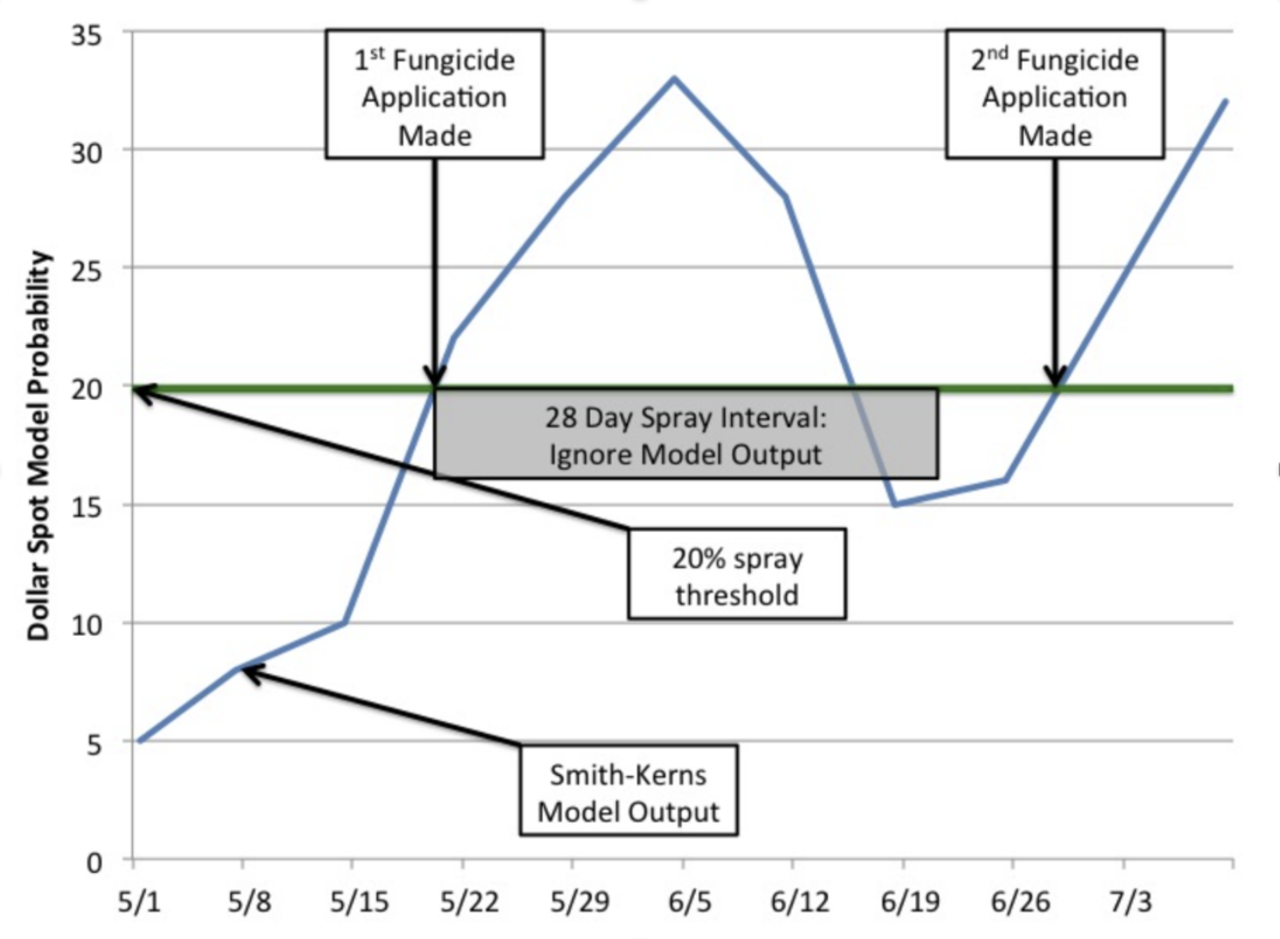
Fact Sheets And Publications

Dollar Spot of Turfgrass
Dollar spot is an economically important disease of both cool-season and warm-season turfgrass. Due to the persistent nature of this disease, more money is spent on managing dollar spot than any other turfgrass diseases. Dollar spot reduces the aesthetic and playing quality of turfgrass.
Causal Organism
Dollar spot is a foliar disease caused by fungi in the genus Clarireedia (formerly Sclerotinia homoeocarpa). Four dollar spot pathogens are in the genus Clarireedia: C. jacksonii, C. monteithiana, C. homoeocarpa, and C. bennettii. However, most of the dollar spot disease incidences worldwide are caused by C. jacksonii and C. monteithiana, which occur on cool-season and warm-season grass hosts, respectively. any other turfgrass diseases.
Disease Cycle
The dollar spot fungus survives unfavorable periods as dormant mycelium in living or dead plant tissues, or as darkly pigmented, thick-walled masses of mycelium called stromata. The fungal mycelium enters plants primarily through cut leaf tips or stomates.
This disease is prevalent from late spring to early winter when the temperature is between 15-32 °C (60-90 °F) and is favored by warm days, cool nights, and prolonged leaf wetness. The pathogen rarely produces spores and spreads mainly by the movement of infected plant material through wind, water, or equipment, such as mowers, golf carts, and sprayers.
Nitrogen-deficient turfgrass is more susceptible to dollar spot and has slower recovery from the disease than well-fertilized turf. Drought stress, a low mowing height, heavy thatch buildup, frequent watering, and low air circulation are conducive for disease development.
Signs and Symptoms
Dollar spot symptoms vary depending on mowing practices. Individual leaf blades develop chlorotic lesions, which turn water-soaked and straw-colored with time. Lesions extend on the leaf, becoming hourglass-shaped, and lead to dieback of the leaf tip.
On closely cut turfgrass, such as golf greens, symptoms appear as small, circular, straw‑colored, sunken spots about the size of a silver dollar (Fig 1.). The spots are distinct and seldom exceed two to three inches in diameter.
On higher cut turfgrasses, such as fairways, roughs, or home lawns, symptoms occur as irregularly-shaped, bleached patches ranging from four to six inches or more in diameter. If the disease is not promptly managed, individual patches may coalesce, forming large, irregular patches, eventually leading to plant death.
Mathematical Equations for the Smith-Kerns Dollar Spot Model
Logit (μ) = -11.4041 + (0.0894 X MEANRH) + (0.1932 X MEANAT)
where, MEANAT = five-day average temperature in Celsius
MEANRH = five-day average relative humidity
The probability is then calculated by plugging the logit (µ) into the following equation:
Probability of a dollar spot epidemic = elogit (μ)/(1 + elogit (μ)) X 100
where, ‘e’ is the ‘Euler’s Number’ and is approximately equal to 2.718.
NOTE: The model is not effective when the average temperature for 5 days is below 10°C or above 35°C as dollar spot fungus is not active beyond these temperature levels.
White cottony mycelium may be seen on infected grass areas in the early morning hours when the pathogen is active, and dew is present.

The Smith-Kerns Dollar Spot Model
Previously, dollar spot control applications were based on a calendar day or a combination of calendar day and weather conditions. In 2018, Damon L. Smith (University of Wisconsin-Madison) and James P. Kerns (North Carolina State University) developed a model to predict the probability of dollar spot outbreak based on the five-day average temperature (Celsius) and five-day average relative humidity.
How to use the model
- Determine the spray threshold at which you choose to apply dollar spot treatment. The threshold can vary based on turf type, cultural practices, environmental conditions, and climate.
- Using the model, apply the fungicide that controls dollar spot once the spray threshold has been surpassed. Wait until the application interval ends.
- Once the application interval has been reached, the model should be run again to determine the next application period.
For example, in Figure 2 from Dr. Koch, the fungicide is applied on May 21st when the model probability goes above the spray threshold (assumed 20 %). The fungicide application is expected to give 28 days of control, so the model output is ignored for 28 days. However, after 28 days, the model is run again, and fungicide is applied again when the threshold is reached (June 27th). This process is repeated throughout the growing season.

- Excel files to determine dollar spot probability can be accessed using the following links.
Smith-Kerns Dollar Spot Probability Calculator-Fahrenheit
Smith-Kerns Dollar Spot Probability Calculator-Celsius
Dollar spot probability can be calculated by simply entering daily average relative humidity and daily average temperature for the area in the excel file.
- Syngenta also provides Dollar Spot Alerts based on the Smith-Kerns model. Syngenta provides season-long text and email notifications along with the ability to forecast dollar spot development risk five days into the future.
Disease Management
Cultural:
- Use resistant cultivars to reduce disease incidence. Turfgrass cultivars vary greatly in susceptibility to dollar spot. See recent resistance data at NTEP.org. Go to the NTEP site, click on the grass species of interest, and check the disease data in the latest NTEP report.
- Maintain adequate nitrogen fertility. Do NOT over fertilize as it can increase susceptibility to other turfgrass diseases such as brown patch.
- Irrigate in the early morning to reduce leaf wetness period. Irrigate deeply and infrequently based on the moisture status of the soil, avoiding any drought stress. Avoid irrigating in the late afternoon or evening. Do NOT over water.
- Remove dew and guttation fluids from leaf surfaces early in the morning by mowing, rolling, whipping, or poling greens.
- Excess thatch may be a source of inoculum for pathogen growth when the conditions are favorable. Manage excessive thatch accumulation by vertical mowing, power raking, aerification, sand topdressing, etc.
- Prune nearby trees or shrubs to improve light penetration and air circulation for rapid drying of the turf.
- Wash the equipment before using on disease-free areas, as dollar spot is easily disseminated with diseased plant material. Carefully remove and dispose clippings from infected turf areas.
Chemical:
- Fungicide applications, in addition to cultural practices, may be necessary to ensure successful disease management. Always read fungicide labels carefully before application and check for any site application restrictions.
- Dollar spot can be managed using fungicides with active ingredients of myclobutanil, fenarimol, propiconazole, boscalid, thiophanate-methyl, triadimefon, and chlorothalonil. Label rates of fungicides should be applied at 7-21 day intervals depending on whether the application is preventive or curative.
- Use an integrated pest management (IPM) approach to prevent development of fungicide resistance. After each treatment, switch between fungicide classes, or use a tank-mix of systemic and contact fungicides.
References:
- Smith, D. L., Kerns, J. P., Walker, N. R., Payne, A. F., Horvath, B., Inguagiato, J. C., Tomaso-Peterson, M., and Koch, P. L. 2018. Development and validation of a weather-based warning system to advise fungicide applications to control dollar spot on turfgrass. PLoS One 13:e0194216. https://doi.org/10.1371/journal.pone.0194216
Authors:
Charanpreet Kaur
Department of Plant and Soil Sciences
University of Delaware
John Emerson
Turfgrass Nutrient Management Agent
UD Cooperative Extension
UD Cooperative Extension
This institution is an equal opportunity provider.
In accordance with Federal law and U.S. Department of Agriculture policy, Cooperative Extension is prohibited from discriminating on the basis of race, color, national origin, sex, age, or disability.
